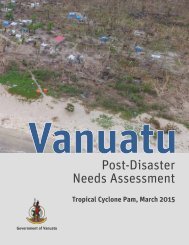Fiji
yqgk302EGjo
yqgk302EGjo
Create successful ePaper yourself
Turn your PDF publications into a flip-book with our unique Google optimized e-Paper software.
FIJI Post-Disaster Needs Assessment<br />
Table 48: Materials Grant for Different Levels of Damage in the Housing Sector<br />
Level of Damage Materials Grant Amount (F$) Purpose<br />
Minor damage to the roof 1,500 Sufficient to jump start partial repairs<br />
Major damage to the roof 3,000 Sufficient to jump start partial repairs<br />
House destroyed 7,000 Sufficient to construct one room (15m 2 floor area) and withstand<br />
Category 3 wind speeds<br />
Source: Estimations by Assessment Team.<br />
Following vetting by the Department of Social Welfare, eligible households will be issued e-cards (provided for free by<br />
Vodafone <strong>Fiji</strong> Ltd.) to hold the small grant funds. The e-cards may be used to purchase materials from eligible, pre-qualified<br />
(by the Ministry of Finance) materials suppliers. The e-card system is expected to be effective by May 2016 and the first<br />
round of grants (up to F$70 million) will close in June 2016.<br />
Owner-led housing reconstruction approaches, similar to the Help for Homes initiative, have been successfully implemented<br />
in a number of countries and aim to ensure that limited public funds are spread widely to assist as many affected families<br />
as possible. However, in order to be successful, and to ensure that no household is left behind during the reconstruction,<br />
house repairs are carried out to an acceptable construction standard and suitable building materials (even where salvaged)<br />
are used, the household repairs process must be supported. Ideally and in keeping with a strong rural housing tradition in<br />
<strong>Fiji</strong>, households will initially be encouraged to form ‘buddy’ groups of five to 10 households to work together to purchase<br />
necessary construction materials in bulk and to repair or reconstruct the houses in their group. Furthermore, provinciallybased,<br />
mobile support units consisting of building advisors and community caseworkers will be fielded (contracted in from<br />
the private sector to supplement government staff) to closely monitor progress being made by all households/groups and<br />
to provide on the spot design and construct advice and social counseling as needed. There is a need for: the provision<br />
of pre-approved model house plans 98 that can be incrementally extended; training of local builders in cyclone-resilient<br />
construction; a well-coordinated and ongoing public information and education campaign urging households to make use<br />
of sound construction techniques and properly specified building materials; and information regarding where to obtain<br />
building and counseling advice throughout the reconstruction. Furthermore, particularly in informal settlements where<br />
tenure security is not yet unambiguously recorded, a simple addressing system with occupancy rights may need to be<br />
introduced, where appropriate, to underwrite householders’ own willingness to invest personal resources into the houses.<br />
Overall, approximately 38 percent of building materials will need to be imported; for example, required quantities of suitable<br />
treated framing timber is already in short supply. 99<br />
The government aims to complete the initial phase of Help for Homes recovery within 24 months. These ‘softer’ support<br />
activities should be established as soon as possible and should be fully funded for an initial three years. They should then be<br />
funded at a lower level of intensity for an additional two to three years, recognizing that once households have undertaken<br />
initial repairs/construction of one room with the Help for Homes materials grants, incremental improvements and additions<br />
will continue to be made to the homes over many years by households using only their own resources. Full recovery of<br />
the housing sector to pre-Winston levels (particularly in regards to the size of houses) and incrementally strengthening the<br />
housing stock for future extreme weather events is likely to take at least a decade to achieve.<br />
The value of the total recovery and reconstruction needs for the housing sector are F$857.3 million. Table 49 provides<br />
the breakdown of total recovery needs for the housing sector. More information on how the recovery will make use of<br />
the supported owner-group reconstruction approach (Help for Homes) is set out in Annex 5: Supplementary Material for<br />
Housing Sector.<br />
Table 49: Total Recovery and Reconstruction Needs for the Housing Sector (F$ million)<br />
Preparatory work and strengthening the<br />
regulatory and technical environment<br />
Design, construction and reconstruction of<br />
homes, and replacement of household items<br />
Recovery Reconstruction Resilience Total<br />
0.3 19.5 19.8<br />
834.1 834.1<br />
Transportation costs 3.4 3.4<br />
Total 0.3 857.0 857.3<br />
Source: Estimations by Assessment Team.<br />
Note: A detailed breakdown of recovery needs by sector is included in Annex 2.<br />
98<br />
The house plans also should incorporate design features to counter domestic violence risks, for example, two external doors on the main<br />
room.<br />
99<br />
According to one expert opinion, over and above the normal framing timber requirements, the short-term housing reconstruction needs<br />
show an immediate shortfall of 10,000 m 3 treated framing timber.<br />
Tropical Cyclone Winston, February 20, 2016<br />
77



